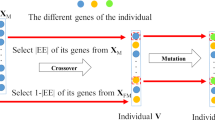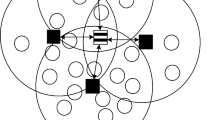Abstract
In wireless local area networks, adjusting the coverage of access points (APs) may force the clients near the coverage boundaries of congested APs to associate with lightly-loaded ones, thus realizing load-balancing. Such an approach has the advantage of requiring no modification on the client software/hardware compared to other load-balancing techniques. However, its applicability is undermined by the problems of AP service cheating and AP service loophole resulted from coverage adjustment, which significantly affect the AP service availability. Nevertheless, these two problems are largely ignored by the existent research. To tackle this challenge, a variable polyhedron genetic algorithm (GA) is proposed, which not only provides an AP service availability guarantee but also yields a near-optimal beacon range for each AP when the number of evolutions is large enough. Simulation study indicates that our algorithm is superior over the default 802.11 AP association model in terms of load-balancing and network throughput enhancement. In addition, the variable polyhedron GA outperforms the traditional GA in terms of fitness value and convergence speed.






















Similar content being viewed by others
Notes
Here “simultaneously” means multiple clients access the wireless media at the beginning of a time slot in a CSMA-based WLAN network.
In this study, we choose to employ a disk-shaped coverage for each AP because it is a good approximation of an AP’s coverage: WiFi signals can penetrate walls and other barriers without much difficulty, which justifies why many relevant research adopts the same assumption of disk-shaped coverage [7, 20].
Actually, our algorithm is applicable to a more general case where R could have any shape.
Algorithm 2 simply enforces the three conditions outlined in Sect. 4.2 by enlarging the BRs of some APs to provide full BR coverage conditioned on the full TR coverage. Similarly, it can be used to enlarge the TRs of some APs to obtain a full TR coverage, assuming that maximum data powers provide a full TR coverage.
References
Henderson, T., Kotz, D., & Abyzov, I. (2004). The changing usage of a mature campus-wide wireless network. In The 10th annual international conference on mobile computing and networking (MobiCom ’04) (pp. 187–201). New York, NY, USA: ACM.
Garcia, E., Vidal, R., & Paradells, J. (2008). Cooperative load balancing in ieee 802.11 networks with cell breathing. In IEEE symposium on computers and communications (ISCC), July 2008, pp. 1133–1140.
Balachandran, A., Voelker, G. M., Bahl, P., & Rangan, P. V. (2002). Characterizing user behavior and network performance in a public wireless lan. In ACM SIGMETRICS international conference on measurement and modeling of computer systems (SIGMETRICS)(pp. 195–205). New York, NY, USA: ACM.
Balazinska, M., Castro, P. (2003). Characterizing mobility and network usage in a corporate wireless local-area network. In The international conference on mobile systems, applications and services (MobiSys’03) (pp. 303–316). New York, NY, USA: ACM.
Vasudevan, S., Papagiannaki, K., Diot, C., Kurose, J., & Towsley, D. (2005). Facilitating access point selection in ieee 802.11 wireless networks. In ACM SIGCOMM conference on internet measurement (IMC) (pp. 26–26). Berkeley, CA, USA: USENIX Association.
Yukuda, Y., & Oie, Y. (2004). Decentralized access point selection architecture for wireless lans deployability and robustness. In Vehicular technology conference (Vol. 2, pp. 1103–1107). September 2004.
Bejerano, Y., Han, S.-J., & Li, L. E. (2004). Fairness and load balancing in wireless lans using association control. In The 10th annual international conference on mobile computing and networking (MobiCom ’04) (pp. 315–329). New York, NY, USA: ACM.
Nicholson, A. J., Chawathe, Y., Chen, M. Y., Noble, B. D., & Wetherall, D. (2006). Improved access point selection. In The 4th international conference on mobile systems, applications and services (MobiSys’06) (pp. 233–245). New York, NY, USA: ACM.
Gong, H., Nahm, K., & Kim, J. W. (2008). Distributed fair access point selection for multi-rate ieee 802.11 wlans. In IEEE consumer communications and networking conference (CCNC), January 2008, pp. 528–532.
Yen, L.-H., Yeh, T.-T. (2006). Snmp-based approach to load distribution in ieee 802.11 networks. In IEEE 63rd vehicular technology conference (Vol. 3, pp. 1196–1200), May 2006.
Sawma, G., Aib, I., Ben-El-Kezadri, R., & Pujolle, G. (2008). Alba: An autonomic load balancing algorithm for ieee 802.11 wireless networks. In IEEE network operations and management symposium (NOMS), April 2008, pp. 891–894.
Bejerano, Y., & Han, S.-J. (2009). Cell breathing techniques for load balancing in wireless lans. IEEE Transactions on Mobile Computing, 8(6), 735–749.
Bahl, P., Hajiaghayi, M., Jain, K., Mirrokni, S., Qiu, L., & Saberi, A. (2007). Cell breathing in wireless lans: Algorithms and evaluation. IEEE Transactions on Mobile Computing, 6(2), 164–178.
Gong, D., & Yang, Y. (2012). Ap association in 802.11 n wlans with heterogeneous clients. In IEEE INFOCOM, 2012.
Xu,F., Tan, C., Li, Q., Yan, G., & Wu, J. (2010). Designing a practical access point association protocol. In IEEE INFOCOM, 2010.
Guo, F., & Chiueh, T. (2005). Scalable and robust wlan connectivity using access point array. In International conference on dependable systems and networks (DSN), June 2005, pp. 288–297.
Le, Y., Ma, L., Yu, H., Cheng, X., Cui, Y., Al-Rodhaan, M. A., & Al-Dhelaan, A. (2011). Load balancing access point association schemes for ieee 802.11 wireless networks. In Wireless algorithms, systems, and applications, Vol. 6843. Lecture notes in computer science, pp. 271–279.
Chen, X., Zhao, Y., Peck, B., Qiao, D. (2012). Sap: Smart access point with seamless load balancing multiple interfaces. In IEEE INFOCOM, 2012.
Velayos, H., Aleo, V. & Karlsson, G. (2004). Load balancing in overlapping wireless lan cells. In IEEE International Conference on Communications, 2004.
Kim, J., Kim, S., Choi, S., & Qiao, D. (2006). Cara: Collision-aware rate adaptation for ieee 802.11 wlans. In IEEE INFOCOM, 2006.
Sheather, S. J. (2004). Density estimation. Statistical Science, 19(4), 588–597.
Yin, H., & Allinson, N. (2001). Self-organizing mixture networks for probability density estimation. IEEE Transactions on Neural Networks, 12(2), 405–411.
Liu, X., & Haengoi, M. (2004). Throughput bounds and energy consumption of mobile multihop networks. In IEEE vehicular technology conference (vol. 6, pp. 4446–4450). September 2004.
Ma, Z. (2004). Operation research and optimization theory. Beijing, China: Tsinghua university publish house.
Gilbert, E. (1965). The probability of covering a sphere with n circular caps. Biometrika 56, 323–330.
Hall, P. (1985). On the coverage of k-dimensional space by k-dimensional spheres. Annals of probability, 13(3), 991–1002.
Ieee 802.11-1999, part 11: Wireless lan medium access control (mac) and physical layer (phy) specifications, ieee std, August 1999.
Acknowledgments
This work has been supported by the National Natural Science Foundation of China (No. 61272475 and No.61003225), and the National Science Foundation of the US (CNS-0831852).
Author information
Authors and Affiliations
Corresponding author
Rights and permissions
About this article
Cite this article
Wang, S., Huang, J., Cheng, X. et al. Coverage adjustment for load balancing with an AP service availability guarantee in WLANs. Wireless Netw 20, 475–491 (2014). https://doi.org/10.1007/s11276-013-0615-8
Published:
Issue Date:
DOI: https://doi.org/10.1007/s11276-013-0615-8




